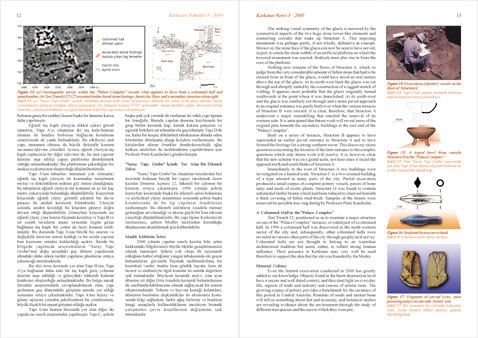|
Figure 13:
(13a) Geomagnetic
survey within the "Palace Complex" reveals what appears to
have been a columned hall and antechamber;
(13b)
Test Trench (TT) 22 revealed timber-laced stone footings, burnt clay
floor, and a secondary structure at top right.
The striking visual symmetry of the glacis is mirrored by the symmetrical
aspects of the two huge stone tower-like elements and connecting corridor
that make up Structure A. This imposing monument was perhaps partly,
if not wholly, defensive in concept. Moreover, the stone face of the
glacis can now be seen to have served, in part, to retain the stone
rubble of an artificial platform on which the towered monument was erected.
Bedrock must also rise to form the core of the platform.
Nothing now remains of the floors of Structure A, which, to judge from
the very considerable amount of fallen stone that had to be cleared
from in front of the glacis, would have stood several meters above the
top of the glacis. At its north-west limit the glacis was cut through
and abruptly ended by the construction of a ragged stretch of walling.
It appears most probable that the glacis originally turned southwards
at the point where it was demolished. At its south-west end the glacis
was similarly cut through and a stone paved approach to an original
entrance was partly built over when the various terraces of Structure
B were erected. It is clear, therefore, that Structure A underwent a
major remodelling that entailed the removal of its western side. It
is anticipated that future work will reveal more of the original plan
beneath the secondary buildings at the east end of the "Palace
Complex".
Built on a series of terraces, Structure B appears to have superseded
an earlier paved entrance to Structure A and to have formed the footings
for a strong southern tower. This discovery raises questions concerning
the location of the later entrance to the complex questions which only
future work will resolve. It is, however, clear that the new scheme
was on a grand scale, not least since it recast the opposed north and
south flanks of Structure A.
Immediately to the west of Structure A two buildings were investigated
on a limited scale. Structure C is a two-roomed building of a type attested
in many parts of the city. Partial excavation produced a small corpus
of complete pottery vessels, pieces of bone inlay and seeds of exotic
plants. Structure D was found to contain substantial timber beams which
had been reduced to charcoal beneath a thick covering of fallen mud-brick.
Samples of the beams were removed for possible tree-ring dating by Professor
Peter Kuniholm.
A Columned Hall in the
"Palace Complex"
Test Trench 22, positioned so as to examine a major structure on one
of the "Palace Complex" terraces, revealed part of a columned
hall. In 1996 a columned hall was discovered in the north-western sector
of the city and, subsequently, other columned halls were revealed in
various other parts of the city through geophysical survey. Columned
halls are not thought to belong to an Anatolian architectural tradition
but seem, rather, to reflect strong Iranian influence. Their presence
at Kerkenes may very well be used therefore to support the idea that
the site was founded by the Medes.
Material Culture
Even the limited excavation conducted in 2000 has greatly added to our
knowledge. Objects found in the burnt destruction level have a secure
and well dated context, and thus shed light on everyday life, aspects
of trade and industry and canons of artistic taste. The growing corpus
of pottery provides a benchmark for the ceramics of this period in Central
Anatolia. Remains of seeds and animal bone will tell us something about
diet and economy, and botanical studies are revealing evidence about
the environment through the study of different tree species and the
uses to which they were put.
Figure
14: Excavation of pottery vessels on the floor of Structure C.
Figure
15: A tripod bowl from outside Structure D in the "Palace Complex".
Figure
16: Socketed bronze arrowhead.
Figure
17: Fragment of carved ivory, once possesing inlays on one side.
Actual size.
|



